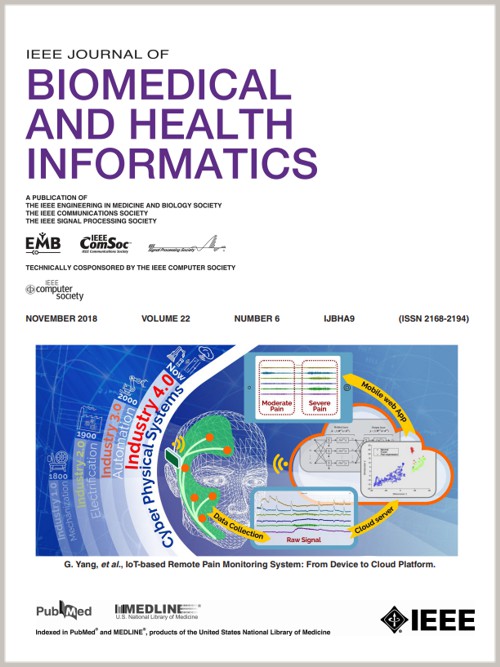利用双向降维和原型学习对高维脑电图图谱表示进行增量分类
IF 6.7
2区 医学
Q1 COMPUTER SCIENCE, INFORMATION SYSTEMS
IEEE Journal of Biomedical and Health Informatics
Pub Date : 2024-11-07
DOI:10.1109/JBHI.2024.3491096
引用次数: 0
摘要
在脑机接口(BCI)系统中,经常利用黎曼空间中的对称正定(SPD)流形来提取脑电图(EEG)信号的空间特征。然而,SPD 矩阵固有的高维度带来了过多的计算负担,阻碍了此类生物识别(BCI)的实时应用,尤其是在处理增量学习等动态任务时。用传统的降维(DR)方法直接降低 SPD 矩阵的维度会改变 SPD 矩阵的基本属性。此外,目前用于增量学习的 DR 方法总是需要保留旧数据,以便在新映射下更新其表征。为此,我们提出了一种用于 SPD 流形的双向二维主成分分析法(B2DPCA-SPD)来降低 SPD 矩阵的维度,从而使降低后的矩阵保持在 SPD 流形上。之后,B2DPCA-SPD 被扩展到适应增量学习任务,而无需保存旧数据。增量 B2DPCA-SPD 可以与矩阵形成的增长神经气体网络(MF-GNG)无缝集成,实现增量脑电图分类,其中旧分类器中原型的新低维表示可以通过更新的投影矩阵轻松地重新计算。我们在两个公共数据集上进行了广泛的实验,以执行脑电图分类。结果表明,我们的方法大大缩短了计算时间,分别缩短了 38.53% 和 35.96%,分类准确率也比传统方法高出 4.21% 到 19.59%。本文章由计算机程序翻译,如有差异,请以英文原文为准。
Incremental Classification for High-Dimensional EEG Manifold Representation Using Bidirectional Dimensionality Reduction and Prototype Learning
In brain-computer interface (BCI) systems, symmetric positive definite (SPD) manifold within Riemannian space has been frequently utilized to extract spatial features from electroencephalogram (EEG) signals. However, the intrinsic high dimensionality of SPD matrices introduces too much computational burden to hinder the real-time applications of such BCI, especially in handling dynamic tasks, like incremental learning. Directly reducing the dimensionality of SPD matrices with conventional dimensionality reduction (DR) methods will alter the fundamental properties of SPD matrices. Moreover, current DR methods for incremental learning always necessitate retaining old data to update their representations under new mapping. To this end, a bidirectional two-dimensional principal component analysis for SPD manifold (B2DPCA-SPD) is proposed to reduce the dimensionality of SPD matrices, in such way that the reduced matrices remain on SPD manifold. Afterwards, the B2DPCA-SPD is extended to adapt to incremental learning tasks without saving old data. The incremental B2DPCA-SPD can be seamlessly integrated with the matrix-formed growing neural gas network (MF-GNG) to achieve an incremental EEG classification, where the new low-dimensional representations of the prototypes in old classifiers can be easily recalculated with the updated projection matrix. Extensive experiments are conducted on two public datasets to perform the EEG classification. The results demonstrate that our method significantly reduces computation time by 38.53% and 35.96%, and outperforms conventional methods in classification accuracy by 4.21% to 19.59%.
求助全文
通过发布文献求助,成功后即可免费获取论文全文。
去求助
来源期刊

IEEE Journal of Biomedical and Health Informatics
COMPUTER SCIENCE, INFORMATION SYSTEMS-COMPUTER SCIENCE, INTERDISCIPLINARY APPLICATIONS
CiteScore
13.60
自引率
6.50%
发文量
1151
期刊介绍:
IEEE Journal of Biomedical and Health Informatics publishes original papers presenting recent advances where information and communication technologies intersect with health, healthcare, life sciences, and biomedicine. Topics include acquisition, transmission, storage, retrieval, management, and analysis of biomedical and health information. The journal covers applications of information technologies in healthcare, patient monitoring, preventive care, early disease diagnosis, therapy discovery, and personalized treatment protocols. It explores electronic medical and health records, clinical information systems, decision support systems, medical and biological imaging informatics, wearable systems, body area/sensor networks, and more. Integration-related topics like interoperability, evidence-based medicine, and secure patient data are also addressed.
 求助内容:
求助内容: 应助结果提醒方式:
应助结果提醒方式:


